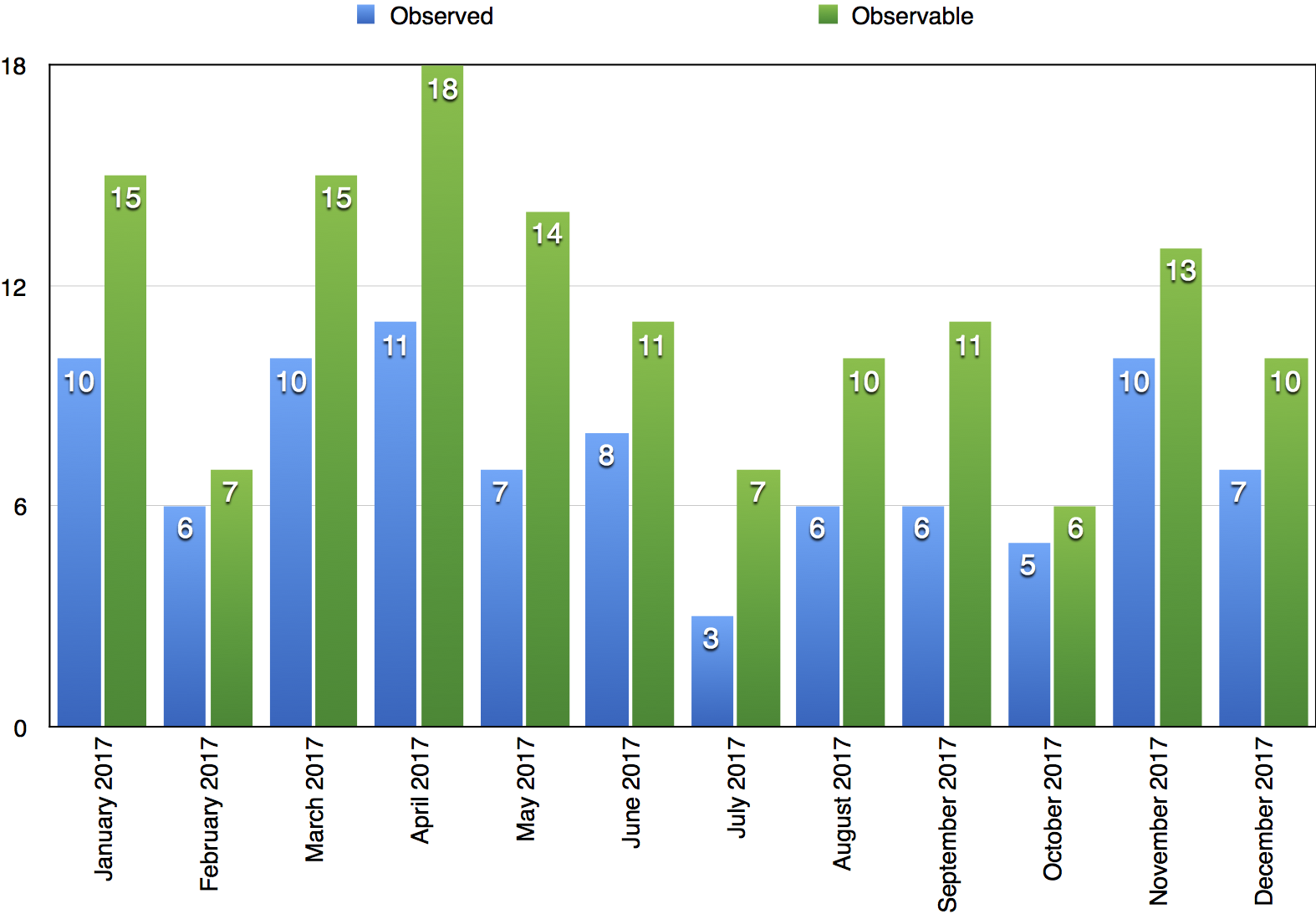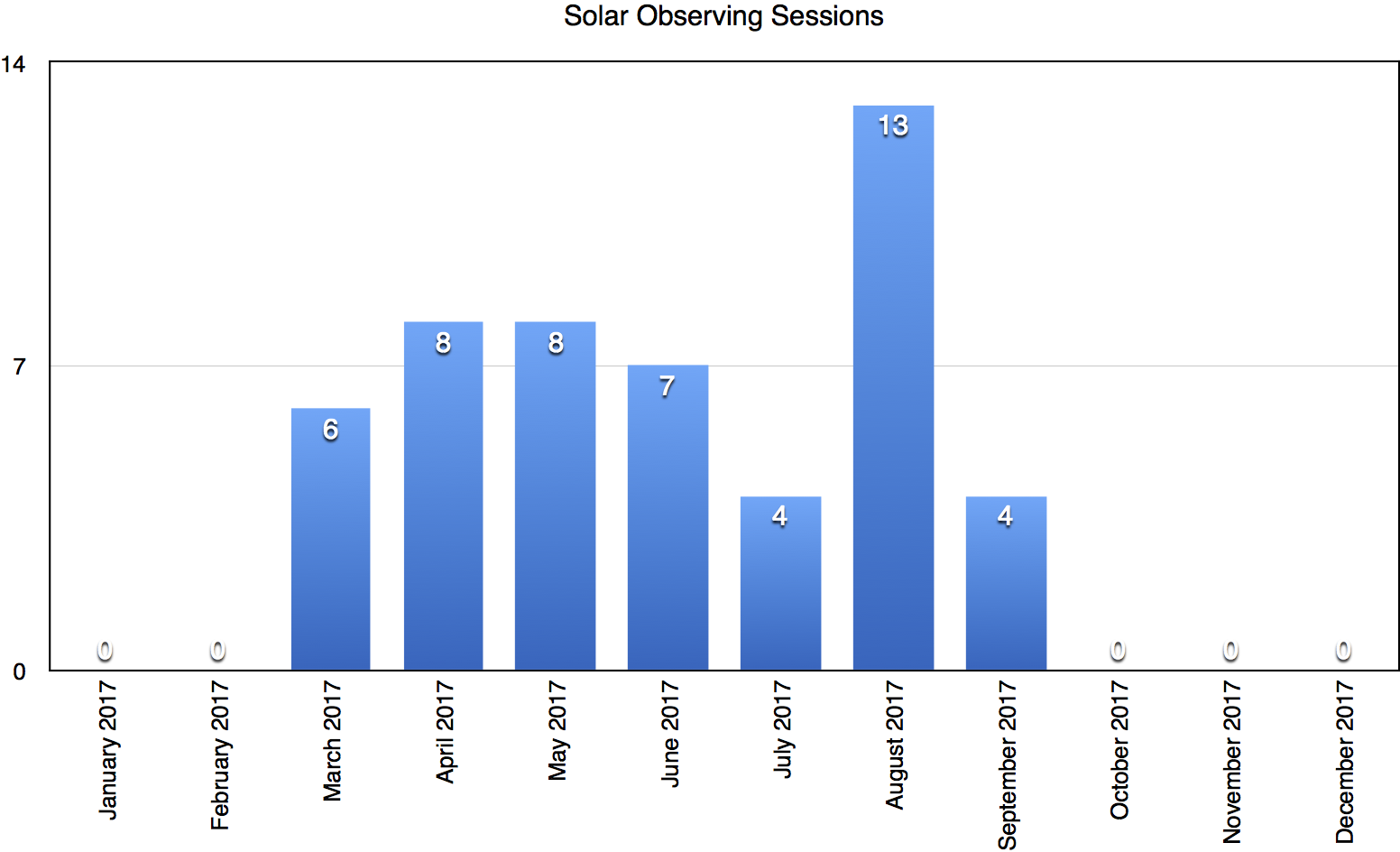Observing in 2017
By James
I think it’s fair to say that I was more active on the blogging front in 2017. Unfortunately I appear to have fallen off the wagon again, so I’ll try to get things rolling with my traditional summary of the last year. I’ve a few more ideas after that so who knows?
The results for 2017
Going back over the diary for 2017 shows about a third of the nights to be observable based on my loose definition.

I feel that the duration of those “clear” skies opportunities have declined, especially in the autumn, a point born out by notes in the diary. There’s no doubt that the quality of my home skies have been in decline for some time due to atmospheric moisture and the rising light pollution from the nearby industrial estates.
Many of those months make great use of the fact that the Moon is quite observable in even relatively cloudy conditions, and the light pollution doesn’t matter one bit. In fact I normally observe the Moon with a bright white light to illuminate my atlas and journal.
I have indeed started lunar sketching in the last year… but not well enough to share yet. At the close of the year I’m down to the final ten sights in the Lunar 100, and some of those will need just the right libration.
The Herschel 400 (H400) list is actually the Herschel 281 for me since I’m limited to objects above the celestial equator. It’s gone reasonably well since I started it last year with 92 objects observed despite the poor deep-sky conditions.
I have pretty much run out of Binocular Messiers to observe from my garden and started on the low altitude Summer Messiers. I’m about a third of the way through this project and progress has been very slow.
Variable star observations topped 1300 at the end of the year and I did receive my certificate from the AAVSO for my first 1000. I was aiming for 1500 in 2018, but that’s going to have to be revised… I hope.
What about Solar?
I’ve been just as active as in 2016 but with a lot more sketching in both Hα and white light using the Herschel wedge… and cheap binoviewers which are excellent for white light in my Starwave achromat.

OK, not quite as many sessions as a packed 2016, but I felt that the quality of the work I was doing was much higher. Most sessions had a sketch and detailed notes.
My plans for 2018
To be frank it’s not started well. Lots of poor weather and a prolonged illness have made it impossible for me to get any scope time for the last month.
Unfortunately I’ve now observed many of the fun objects in the H400 and there are a lot of galaxies remaining. I’ll admit that I’m not a big fan of galaxies. This is partly being limited to 150mm of aperture, which I may able to do something about, but also the poor quality of my sky: any haze and glare makes galaxies invisible.
I’ve kicked off a couple of new programmes focused on objects visible from my home site to make up for a galaxy infested H400.
- The resurrected and revised version of the Astronomical League basic open clusters programme containing 88 clusters.
- A programme to observe 56 bright planetary nebulae.
I have another that may prove to be insane from my garden: 34 objects from the Sharpless HII Regions catalogue. They’re the ones that Stewart Sharpless gave a ‘3’ for Bright, though I suspect that to be a relative term. We’ll see how that goes, I may have for travel far afield to complete it, or leave the Country.
I want to finish off the Binocular Messiers but I need to find a better horizon. I have a few ideas that are considerably more local than those for the Sharpless project and at least binoculars are nothing if not portable. The majority of the outstanding Messiers are spring and summer objects, so I’ll need to get started soon.
Lunar observing is guaranteed to continue. The final few Lunar 100 sights may be a question of waiting for the right opportunity, but I’ve identified a few features of special interest to pursue, research and perhaps even sketch well in the process.
I’d like to try and observe Venus a again this year, but the apparition isn’t very favourable, just better than for all the others. I caught a brief glimpse in binoculars last night at only 5º above the horizon: no chance of getting a scope on it. The planets are mostly hopeless this year I’m afraid.
We march towards solar minimum in the next couple of years, and despite some fireworks last year the beginning of this one hasn’t been promising. The Sun is very quiet. Is this the right time to start learning how to do sun spot counts? I hope for better by the summer.